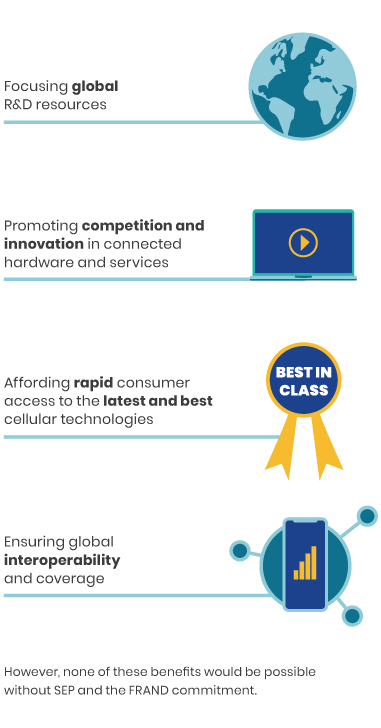STANDARD-ESSENTIAL PATENTS ARE AT THE CORE OF MOBILE COMMUNICATIONS AND MODERN LIFE
Standard-Essential Patents (SEPs) are fundamental to modern society and life. To understand their importance, however, you first need some context.
Cellular communication standards have enabled the creation of cellular phones, smartphones and other mobile, wirelessly connected devices. They enable mobile communication through their use of a complex radio system to transmit data between connected devices across the cellular communication network.
These standards are massively detailed documents. They define every aspect of how the cellular network operates and how devices work within it. The standards are subject to continuous intensive development and have passed through several generations, from 1G to 5G.

Cellular communication standards create the opportunity for the development of new digital services and marketplaces, like the app ecosystem and the Internet of Things (IoT). The system through which they are developed is based on a European model of open, collaborative technology development. This model has four major benefits that have enabled rapid advances in cellular networks, device connectivity, and digital services. These are:

However, none of these benefits would be possible without SEPs and the FRAND commitment.
WHAT IS A SEP?
A Standard-Essential Patent is a patent that protects technology selected for use in a standard. Patented inventions that must necessarily be used when implementing a cellular communication standard are “essential” to that standard. As a result, their owners need to make them available for use under Fair, Reasonable and Non-Discriminatory (FRAND) terms and conditions.
The FRAND principle is carefully balanced to ensure that cellular technology developers and implementers share in the benefits of cellular standardisation. It ensures that the inventors of cutting-edge telecommunication technologies – which cost millions of euros to develop and which inventors contribute voluntarily to the standardisation process – are guaranteed a fair return on their investment. It also ensures that connected hardware manufacturers have access to the cellular communications standard on a reasonable and non-discriminatory basis. FRAND licensing facilitates the widespread use of the standard and ensures that each SEP owner is able to receive a return on the results of its R&D without gaining an unfair bargaining position.

WHY ARE SEPs VITAL TO THE FUNCTIONING OF OPEN CELLULAR STANDARDS?
The system of open cellular standards development needs to meet two key standards to be economically sustainable for all stakeholders.
Firstly, many world-leading research and development intensive organisations, including companies, universities, and public research organisations, need to make a fair return on investment (ROI). They take sizable financial risks to invent cutting-edge new telecommunication technologies for cellular standards. Many of these are not selected for use, but the breadth and intensity of invention are responsible for the extraordinary rate of technical progress we have seen to-date. To continue to invest in cellular telecommunication innovation, these organisations need to have confidence that there is enough potential ROI available from licensing SEP to justify further investment. They need to have confidence that, if their technology is included in a standard, they will receive fair and reasonable compensation.
Secondly, connected hardware manufacturers that use (or ‘implement’) the technology of open cellular standards in their products need to know that they will not later be arbitrarily blocked from using one of the many patented technologies in a cellular standard, or charged a price which is deemed unreasonable or discriminatory in relation to similarly situated implementers. All the patented technology that is included in the standard must be accessible to implementers to ensure that they can fully comply with the technical specifications and provide seamless products and services to end-users.
The carefully balanced system of FRAND licensing of SEPs provides the greatest possible benefits to device and network makers, consumers, and the inventors of telecom-munication technologies alike. The alternative would be a fragmented set of competing proprietary technologies, exclusively owned and used by a few gatekeepers.

For some practical examples of standard-essential patents in action, you might also be interested in this article: https://ipeurope.org/blog/what-has-a-standard-essential-patent-done-for-me-lately-anyway/.
